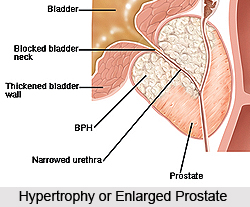 Prostate disorders, problems or symptoms most commonly tend to fall into three common types, comprising: prostatitis, or inflammation of the gland; benign prostatic hyperplasia (BPH), which results in an enlarged prostate that can narrow the urethra; and of course, cancer. Under any circumstance, these three conditions should be urgently referred to a urologist, a doctor who specialises in diseases of the urinary tract. A urologist can thoroughly explicate the treatment options, which may range from drug therapy to surgery. Not every early stage of prostate cancer disorder will produce fatalistic symptoms; it is important that one should have a regular check up and consultation with a doctor.
Prostate disorders, problems or symptoms most commonly tend to fall into three common types, comprising: prostatitis, or inflammation of the gland; benign prostatic hyperplasia (BPH), which results in an enlarged prostate that can narrow the urethra; and of course, cancer. Under any circumstance, these three conditions should be urgently referred to a urologist, a doctor who specialises in diseases of the urinary tract. A urologist can thoroughly explicate the treatment options, which may range from drug therapy to surgery. Not every early stage of prostate cancer disorder will produce fatalistic symptoms; it is important that one should have a regular check up and consultation with a doctor.
The three cardinals and most worrying of the types of prostate disorders can be illustrated as under:
Hypertrophy or Enlarged Prostate - The medical terminology for this non-cancerous type of prostate disorder is benign prostatic hyperplasia (BPH). Generally witnessed in men who have crossed the age of 50, the symptoms begin to come about when the enlarged gland agitates against the urethra, the tube that carries urine away from the bladder. Not unexpectedly then, symptoms would include repeated urination, incomplete vacating of the bladder, a weak urine stream or difficulty to begin to urinate. Besides being non-life threatening, the other fine news connected to this disorder is that BPH does not cause erectile dysfunction and can be successfully cured with proper medication.
 Prostate Cancer - According to the American Cancer Society, this type of prostate disorder, implying cancer is the most plebeian form of cancer in men, leaving out skin cancers. While 1 in every 6 men will be diagnosed with prostate cancer that germinates from the gland cells, only 1 in 35 will die of it. Early screening (the diagnosis process of prostate disorder) is indeed decisive. If the cancer can be detected while it is still in the localised level or regional (spread out of the prostate, but still nearby), the five-year survival rate is almost 100 percent. Localised cancer can be treated with surgery or radiation therapy. For more advanced and complex situations, hormone therapy, in which levels of male hormones are reduced, or chemotherapy can be employed to address the cancer.
Prostate Cancer - According to the American Cancer Society, this type of prostate disorder, implying cancer is the most plebeian form of cancer in men, leaving out skin cancers. While 1 in every 6 men will be diagnosed with prostate cancer that germinates from the gland cells, only 1 in 35 will die of it. Early screening (the diagnosis process of prostate disorder) is indeed decisive. If the cancer can be detected while it is still in the localised level or regional (spread out of the prostate, but still nearby), the five-year survival rate is almost 100 percent. Localised cancer can be treated with surgery or radiation therapy. For more advanced and complex situations, hormone therapy, in which levels of male hormones are reduced, or chemotherapy can be employed to address the cancer.
Prostatitis - This non-life threatening circumstance is the most witnessed type of prostate disorder and problem for men younger than 50. It signifies an inflammation of the prostate gland that may be caused by any infectious agent. There are three major types of prostatitis, each with its own set of symptoms: bacterial, non-bacterial and prostatodynia. A physician is most likely to perform a digital rectal exam or may probe into the prostate fluid under a microscope to assist in making a diagnosis. Risks of developing prostatitis are increased after a bladder infection; if BPH is already a complicated issue; too much of alcohol consumption; eating spicy, marinated foods; injury to the lower pelvis; catching a sexually transmitted disease; or having frequent, unprotected sex. Treatments for these fatal disorders re included in antibiotics, anti-inflammatories and when necessary, by surgery.




















